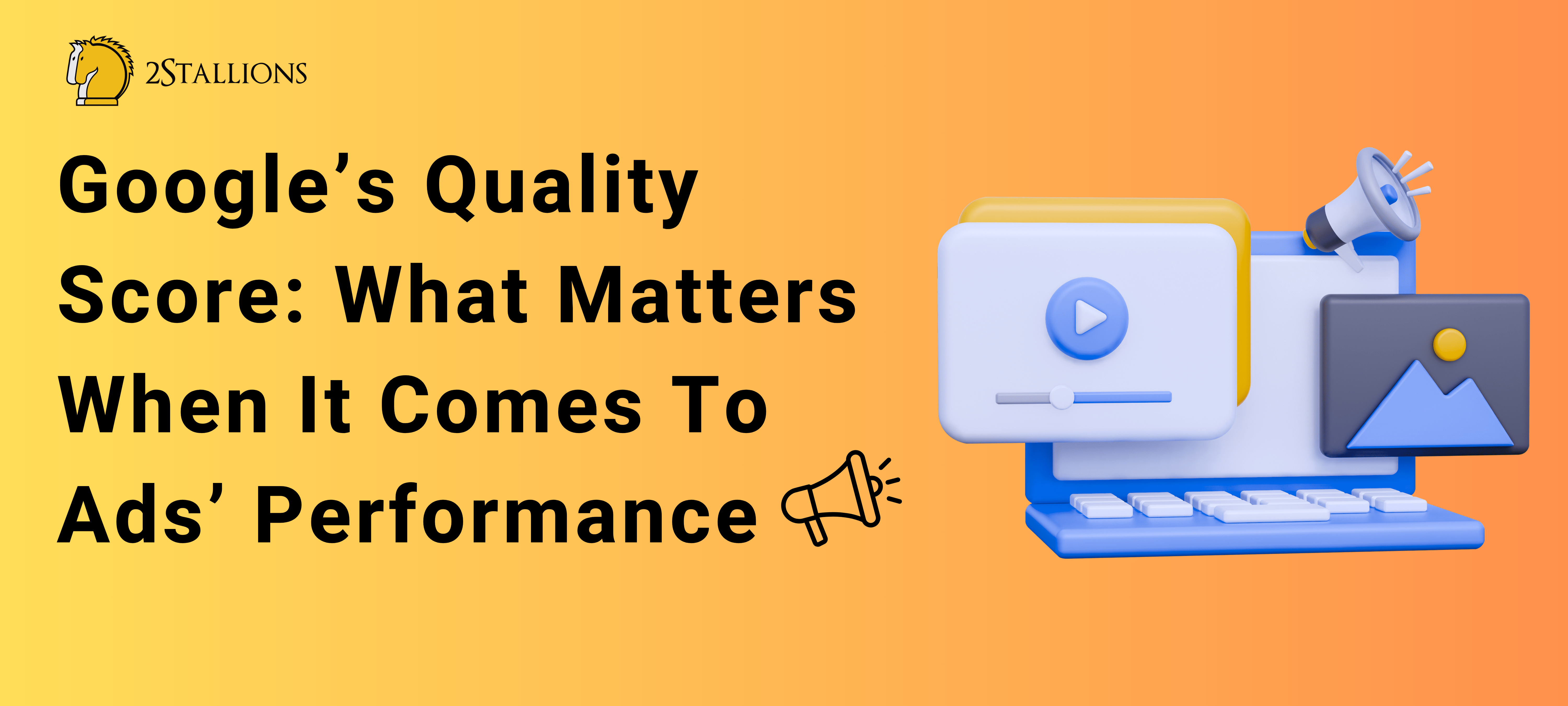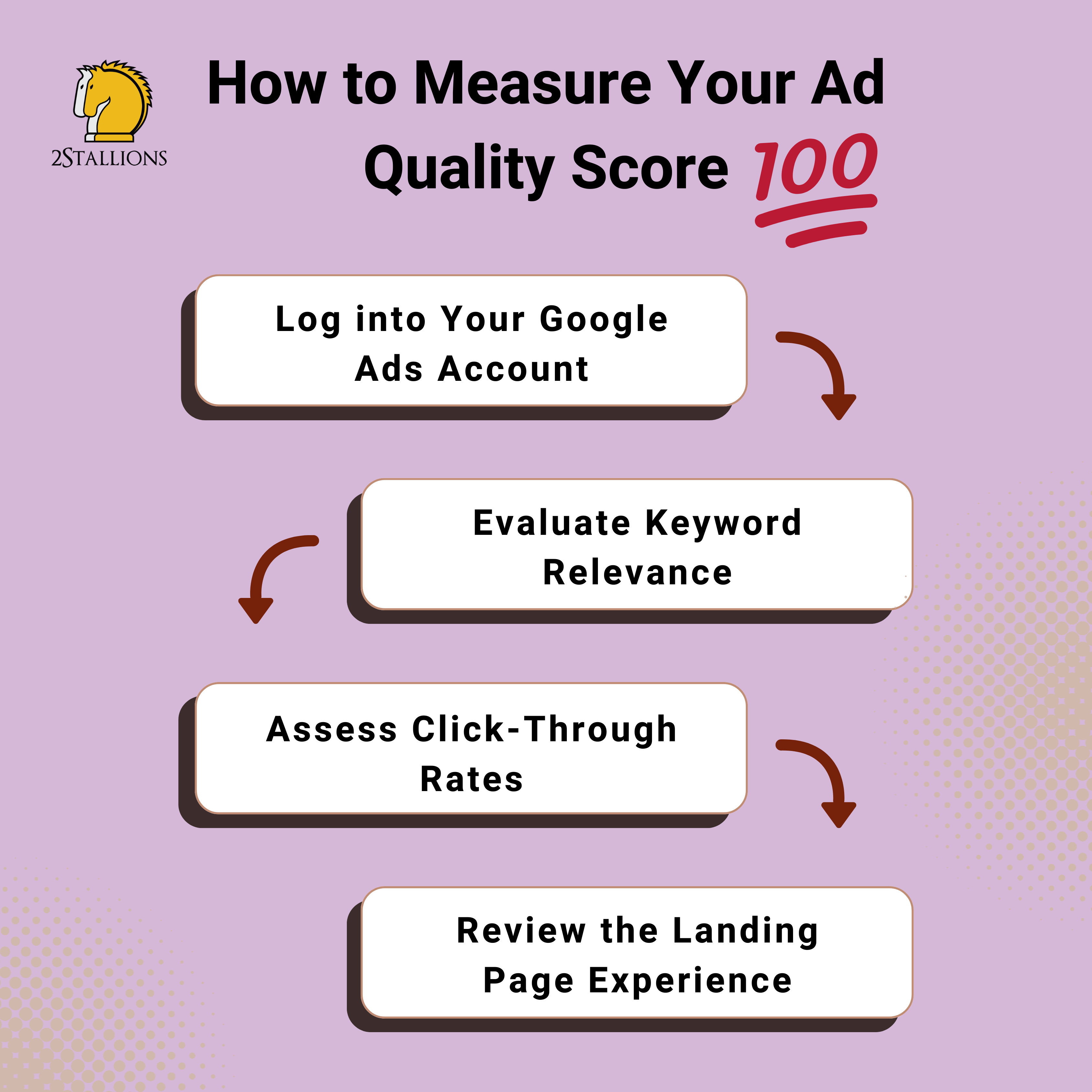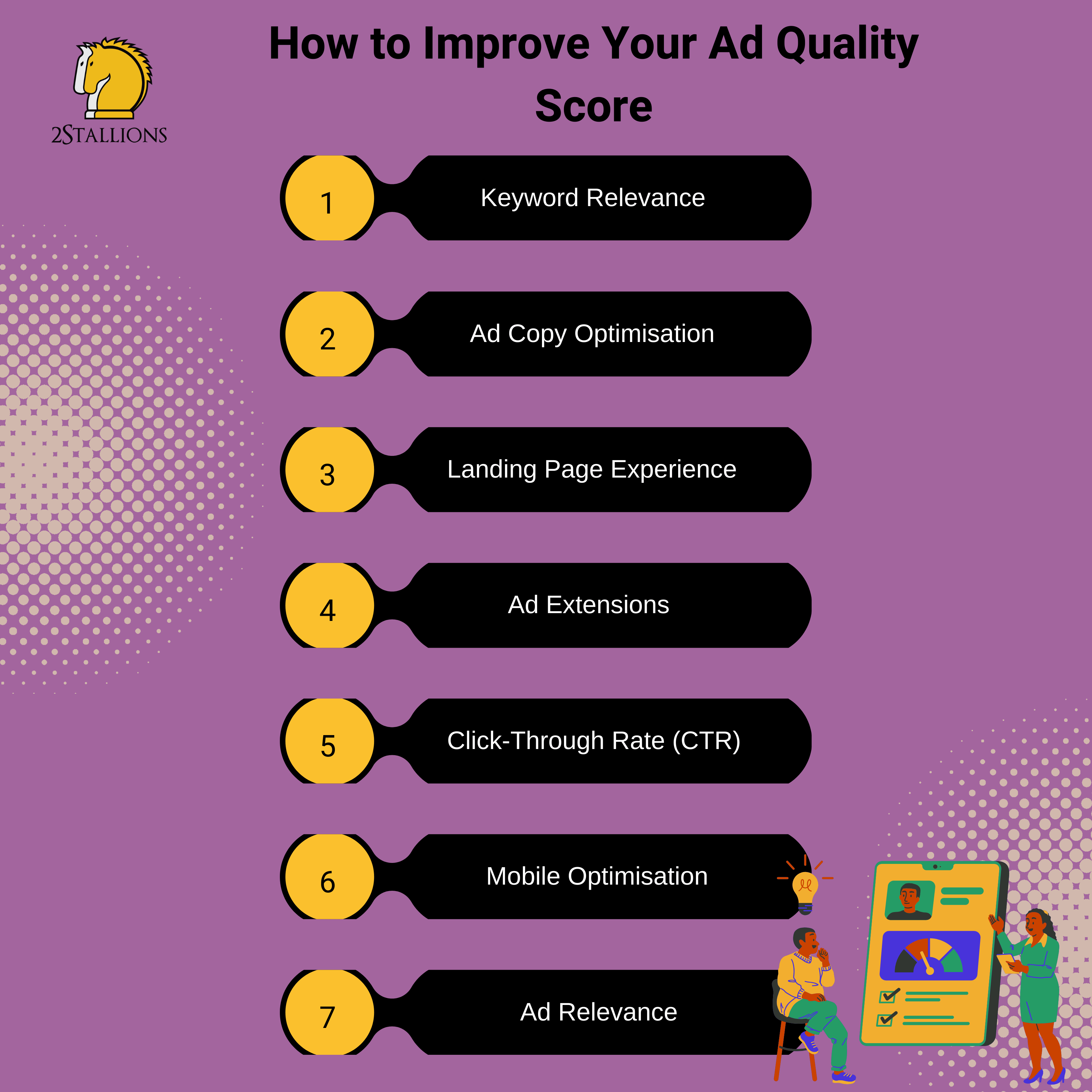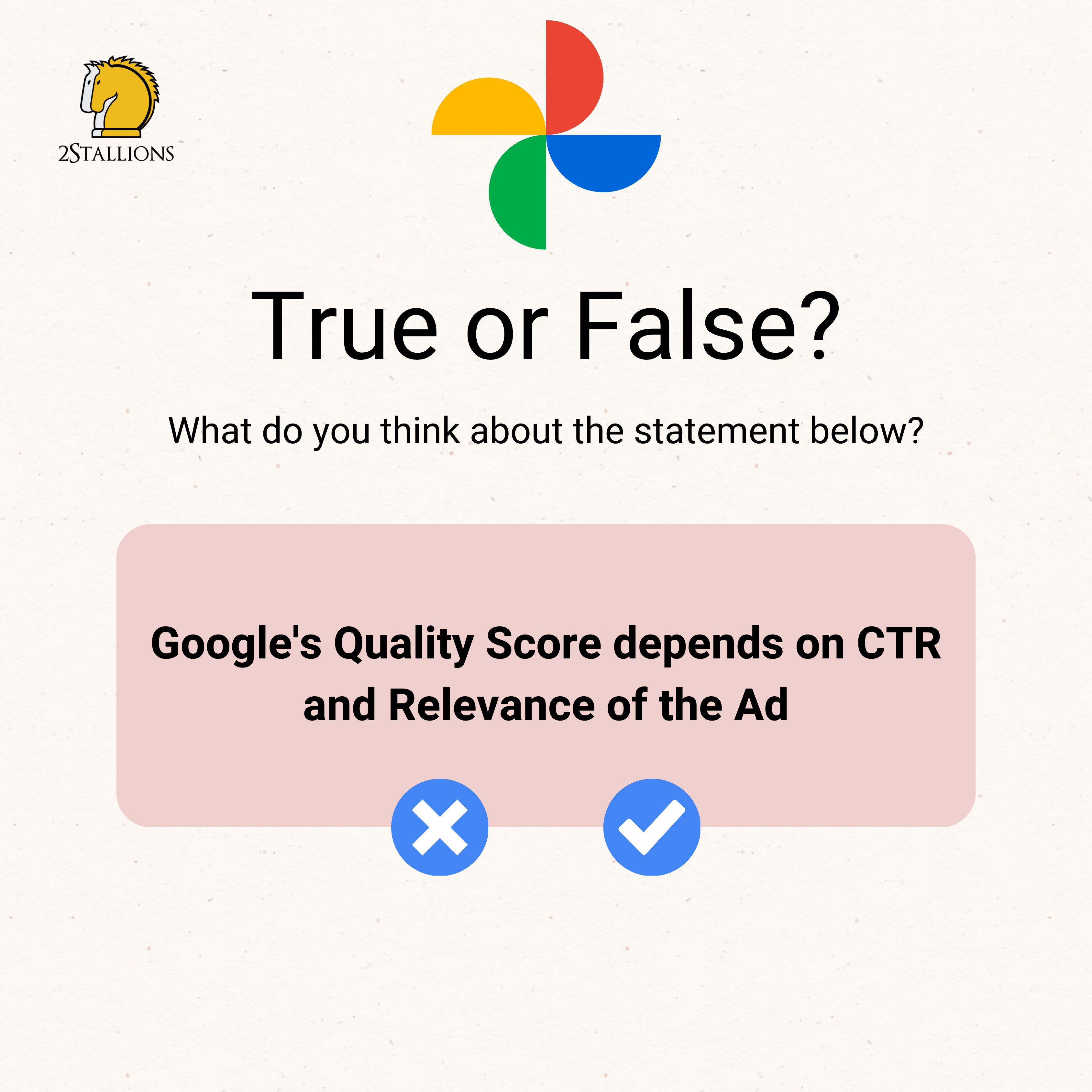SHARE

What Is an Ad Quality Score?
Your ad’s Quality Score is a dynamic evaluation by Google that reflects your ads’ overall quality and relevance. This score is pivotal in determining your ad’s position on the search engine results page (SERP) and the cost-per-click (CPC) you pay. Achieving a high-quality score is crucial for optimising your Google Ads campaign and maximising its effectiveness.
[thrive_leads id=’8346′]
To understand your ad’s performance, you must know how to find quality scores in Google Ads. This process involves navigating your Google Ads account and accessing the relevant metrics and reports. Quality Scores are typically available at the keyword level, allowing you to assess the performance of individual keywords in your campaign.
How to Measure Your Ad Quality Score
Measuring your Ad Quality Score involves navigating through the Google Ads platform. Follow these steps to gain insights into the performance of your ads:
1. Log into Your Google Ads Account
Access your Google Ads account and navigate the campaign you want to analyse. Click on the “Keywords” tab to view a comprehensive list of your selected keywords.
2. Evaluate Keyword Relevance
Examine the relevance of your keywords to the ads they are associated with. Google uses this relevance as a fundamental factor in determining your Quality Score.
3. Assess Click-Through Rates
Analyse your ads’ Click-Through Rates (CTR). A higher CTR indicates that users find your ad content compelling. Identify low-performing ads and consider revising their content to enhance engagement.
4. Review the Landing Page Experience
Evaluate the user experience on your landing pages. Ensure the content aligns seamlessly with the ad, providing valuable information and a clear call to action.
2Stallions is a trusted Google Ads agency and official Google Partner that crafts tailored campaigns to drive high-quality traffic. Our expertise ensures maximum ROI from your advertising budget. Schedule a free consulation with us now.
What Is a Good Quality Score for Google Ads?
The million-dollar question for advertisers is, what is a good Quality Score for Google Ads? A score of 7 or above is considered good, indicating that your ads are highly relevant and engaging. However, striving for a perfect 10 is always ideal.
Here’s a breakdown of what each score range signifies:
1 to 3: Poor. Your ad is deemed less relevant to users, and you may experience higher costs and lower ad positions.
4 to 6: Average. There is room for improvement; optimising your ad content and landing pages can positively impact your campaign performance.
7 to 10: Good to Excellent. Ads with a quality score in this range are considered highly relevant and beneficial to users. You can expect better ad placements and lower costs per click.
How to Improve Your Ad Quality Score
- Keyword Relevance: Ensure your keywords are highly relevant to your ad copy and landing page content. Google rewards ads that are closely related to users’ search terms.
- Ad Copy Optimisation: Craft compelling ad copy that aligns with your targeted keywords. Include relevant and engaging content that encourages users to click.
- Landing Page Experience: Create a user-friendly landing page that provides valuable and relevant information. The landing page should match the intent of the user’s search and offer a seamless experience.
- Ad Extensions: Utilise ad extensions to provide additional information and encourage clicks. This can include site link extensions, callout extensions, and structured snippet extensions.
- Click-Through Rate (CTR): A higher CTR is often associated with a higher Quality Score. Focus on creating ads that attract clicks by being relevant and compelling.
- Mobile Optimisation: Ensure your ads and landing pages are optimised for mobile devices. With a growing number of users accessing the internet through mobile, this can positively impact your Quality Score.
- Ad Relevance: Regularly update and refresh your ad creatives to maintain relevance. Outdated or irrelevant ads can negatively impact your Quality Score.
Importance of Google Ad Quality Score
In digital advertising, grasping the intricacies of the Ad Quality Score in Google Ads is fundamental for advertisers seeking to elevate their online presence. The Quality Score is not merely a numerical assessment; it is a dynamic evaluation by Google, gauging your ads’ overall quality and relevance.
This pivotal metric determines your ad’s placement on the coveted Search Engine Results Page (SERP) and, equally importantly, the Cost-Per-Click (CPC) you incur. Achieving a favourable Quality Score is paramount for advertisers aiming to optimise their Google Ads campaigns and extract maximum value from their advertising investments.
Relevance and User Experience
The Quality Score directly reflects your ads’ relevance and overall quality. Google values advertisements that are relevant to users’ search queries and provide a positive experience. By achieving a high-quality Score, you signal to Google that your ads align well with user intent, improving the overall user experience.
Ad Position on SERP
The Quality Score plays a pivotal role in determining the position of your ads on the Search Engine Results Page (SERP). Ads with higher Quality Scores are more likely to be placed in prominent positions, increasing visibility and the likelihood of attracting clicks. This, in turn, enhances the effectiveness of your advertising efforts.
Cost-Effectiveness
Advertisers with a higher Quality Score often enjoy the benefit of lower Cost-Per-Click (CPC). Google rewards relevant and high-quality ads by offering a more cost-effective pricing structure. Achieving a good Quality Score for Google Ads can significantly impact your advertising budget, allowing you to reach a larger audience while spending less per click.
Optimising Ad Performance
Knowing how to find quality scores in Google Ads is essential for maximising the performance of your advertising campaign. By regularly monitoring and analysing Quality Scores at the keyword level, you can identify areas for improvement. This insight enables you to make informed decisions about keyword selection, ad copy, and landing page optimisation, contributing to overall campaign success.
Maximising ROI
Aiming for a good Quality Score for Google Ads is directly linked to maximising your ROI (ROI). Higher Quality Scores lead to better ad placements, increased click-through rates, and lower costs. This combination results in a more efficient and profitable advertising campaign.
Google’s Quality Score depends on CTR and Relevance of the Ad – True or False?
Understanding the factors contributing to ad Quality Score is crucial for optimising your Google Ads campaign. Indeed, Google’s Quality Score is significantly influenced by two key factors: Click-Through Rate (CTR) and ad relevance. Click-Through Rate (CTR) measures the percentage of people who click on your ad after seeing it. Google uses CTR to indicate how relevant and engaging your ad is to users. A higher CTR is generally associated with more relevant and compelling ads.
Therefore, a substantial CTR can positively impact your Quality Score. To find your Quality Score in Google Ads, navigate to your Google Ads account, select the relevant campaign or ad group, and explore the detailed metrics associated with each keyword. Another critical factor is ad relevance. Google evaluates how well your ad matches the intent behind a user’s search query. The more relevant your ad is to the user’s search, the higher the Quality Score it will likely receive.
Relevance is assessed based on factors such as the ad copy, keywords, and landing page experience. Ensuring that your ads are closely aligned with the user’s intent is essential for achieving a good Quality Score for Google Ads. So, Google’s Quality Score depends on both CTR and ad relevance. These factors determine your ads’ overall quality and effectiveness in Google Ads.
To optimise your Quality Score, focus on creating compelling ad copy, selecting relevant keywords, and providing a seamless and relevant user experience on your landing pages. Regularly monitoring and adjusting your campaign based on these factors will contribute to achieving and maintaining a good Quality Score for Google Ads.
Originally published: 15 April 2020
Updated: 23 November 2023
Are you ready to boost your online presence and start seeing tangible results? Look no further! Our renowned Google Ads agency specialises in crafting customised SEM solutions and leveraging our proven expertise to ensure your success in the digital realm.
Frequently Asked Questions about Google’s Quality Score
What Are The Factors Affecting Quality Score In Google Ads?
Several factors influence the Quality Score in Google Ads. The primary ones include:
- Click-Through Rate (CTR): The percentage of users who click on your ad after seeing it.
- Ad Relevance: How well your ad matches the user’s search intent.
- Landing Page Experience: The quality and relevance of the page users reach after clicking on your ad.
- Ad Copy Relevance: How closely your ad copy aligns with the user’s query and expectations.
- Keyword Relevance: The relevance of your chosen keywords to your ad group and target audience.
- Historical Performance: The past performance of your Google Ads account, including the overall click-through rates and Quality Scores.
Which Factors Does Google Use To Determine An Ad’s Quality Score?
Google employs a combination of factors to assess an ad’s Quality Score, including:
- Click-Through Rate (CTR): The ratio of clicks to impressions.
- Ad Relevance: How well the ad matches the user’s search intent.
- Landing Page Experience: The quality and relevance of the landing page users reach after clicking on the ad.
Does Google Ads Optimisation Score Matter?
Yes, the Google Ads optimisation score matters as it provides insights into the health and effectiveness of your Google Ads account. The optimisation score is a percentage that reflects how well your account is set up to perform. It considers factors such as ad relevance, targeting, and extensions. A higher optimisation score suggests that your account is well-optimised, potentially leading to better overall performance.
What Causes Low-Quality Score Google Ads?
Several factors can contribute to a low-quality Score in Google Ads, including:
- Low Click-Through Rate (CTR): If users are not clicking on your ad, it may indicate a lack of relevance.
- Poor Ad Relevance: If your ad does not align with the user’s search intent, it may receive a lower score.
- Unoptimised Landing Pages: If the landing page is not relevant or user-friendly, it can negatively impact the Quality Score.
- Ad Format Issues: Issues with ad presentation or format may lead to a lower Quality Score.















